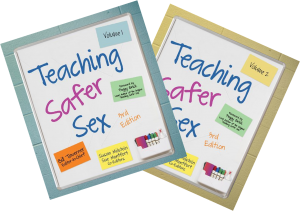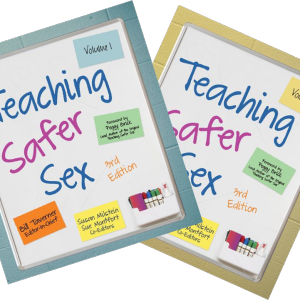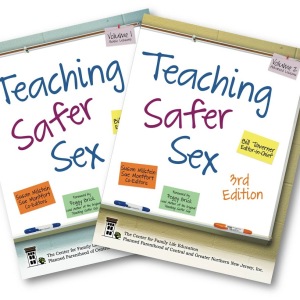Yep, that’s right! Teaching Safer Sex is now up on the Sex Ed Network in its entirety!
In the hardcopy, Teaching Safer Sex has two volumes, although this isn’t readily apparent on the Sex Ed Network. The extensive lessons that are now available through this online repository are:
Section 1 – Sexual Health: An Overview
DEFINING SEXUAL HEALTH
By Kirsten deFur, MPH
This lesson will allow participants to define sexual health, recognize its characteristics, and understand ways to improve and protect their sexual health.
SEXUAL HEALTH IN PRIME TIME
This lesson introduces characteristics that describe sexual health and has participants critically observe and evaluate these traits in their favorite television programs.
I FEEL GOOD!
Sexual Pleasure … Definitions and Values
By Kirsten deFur, MPH
This lesson will help participants explore the meaning and influence of pleasure by developing a Pleasure Mind Map and examining personal values in an Agree/Disagree game.
STI BINGO
STI Bingo is a game that allows youth to apply important information about sexually transmitted infections including modes of transmission, types of STIs, and relevant prevention techniques.
DON’T PASS IT ALONG!
This lesson dramatizes the rapid geometric progression possible in the spread of a sexually transmitted infection and encourages participants to think about the reasons why many people do not protect themselves. It uses incidence and prevalence charts to demonstrate the large number of people who are infectious and emphasizes the importance of honest assessment of one’s own risk.
THE ABCs OF HPV
This lesson is designed to increase participant’s basic knowledge of HPV, so that they understand how it is transmitted, the effects it can have, and how to prevent it.
SAFER SEX
The Basics
Negative attitudes about sexuality, inaccurate information about sexual safety, and denial of one’s own risk can all contribute to individuals’ failure to protect themselves from contracting an STI. This lesson allows participants the opportunity to develop awareness of all three of these aspects of sexual safety and consider the impact of their behaviors on their future sexual health.
Section 2 – Sexual Behaviors, Sexual Decisions
“YOU’RE OUT, BASEBALL!”
A Healthier, More Equitable, Satisfying and Safer Model for Sexual Activity
By Al Vernacchio, MSEd
This lesson raises awareness of the prevalence and power of the “baseball” model of sexual activity and offers an alternative model: the “pizza” model. Participants will think deliberately about which model would benefit them.
MASTURBATION
A Safe, but Touchy Subject
This lesson will help participants examine common attitudes and beliefs about masturbation in a non-threatening, nonjudgmental manner. It also allows them the opportunity to consider, perhaps for the first time, just how valuable masturbation can be as a safe form of sexual expression and pleasure.
MAKING SENSE OF ABSTINENCE
This lesson enables participants to come to terms with how they each define abstinence, their reasons for choosing or not choosing abstinence, how and when they will communicate with partners about their decisions and how they will commit to and carry out their sexual decisions.
ORAL SEX AND ABSTINENCE
Examining the Role of Intimacy in Sexual Decisions
By Nora Gelperin, MEd
This lesson will give participants an opportunity to explore and clarify their beliefs about oral sex and intimacy and how oral sex relates to decisions about abstinence and safer sex.
FIGURING OUT OUTERCOURSE
In this lesson, participants evaluate outercourse as an important sexual option that may fit with a person’s definition of abstinence.
SECURING THE BACK DOOR
A Guide to Safer Anal Sex
By Megan Andelloux
In this lesson, participants dispel common myths about the anus and anal sex, and learn the facts about anal anatomy, as well as sexual health and sexual safety.
SEX, DRUGS AND HEALTHY DECISIONS
By Jennifer Reynolds Valerio and Doris Moran
This lesson will help teens understand basic facts about the relationship between drugs and sexuality, the impact of drugs on sexual decisions, and how to find help.
Section 3 – Condoms: The Basics 117
THE CONDOM LINEUP
By Carolyn Cooperman
The active involvement of participants in this lesson is designed to relieve their anxiety about using condoms by increasing their confidence in condoms as a reliable form of contraception and protection against sexually transmitted infections.
SIZING UP: CONDOM FIT
By Melissa Keyes DiGioia
In this lesson, participants will discover the real-world variation in penile dimension and condom size and learn how to use an instrument to determine and order custom sized-to-fit condoms.
CHOOSING CONDOMS, CHOOSING LUBES
In this lesson participants confront the issue of talking with a partner about condom use, and in addition, reflect on the impact negative attitudes may have on a couple’s ability to protect themselves. Participants examine and evaluate a variety of brands of condoms and personal lubricants and overcome common aversion to touching condoms.
THE PEOPLE PROBLEM
When Condoms Don’t Work
Since most condom failures are, in fact, people failures, it is important to identify and address the reasons people at risk do not use condoms consistently and correctly. This lesson addresses some of the problems people have using condoms.
PERSONALS
Portrait of a Successful Condom User
This lesson advocates an expansion of the definition of sexual attractiveness to include a person’s willingness to communicate about and practice safer sex.
YOUTH: CHOOSE PREVENTION!
By Melissa Keyes DiGioia
This lesson will allow participants to identify ways youth can reduce their risk for STIs. They will consider and discuss reasons for choosing particular prevention techniques in specific situations, and develop suggestions for reducing the spread of STIs.
Section 4 – Talking About Communication
SAY WHAT?!?
Communicating About Safer Sex
By Allyson Sandak
This lesson will provide participants with an opportunity to develop comfort and skills around communicating assertively about safer sex.
TALK IS A FOUR-LETTER WORD – USE IT!
This lesson seeks to alert participants to the issues surrounding communication about sex, and, through role-play, to normalize talking with a partner about sexual safety.
CONDOM TALK
Practice Makes Perfect
By Louise Yohalem
This activity gives participants a chance to confront possible barriers to condom use and to respond to these barriers. After participants have had a chance to develop condom dialogue competence, they get to practice their skills and increase their condom efficacy.
IT TAKES TWO …
To Practice Safer Sex
This lesson helps participants assess the differences between their attitudes about how couples should behave and what actually happens in many relationships. It is designed to reveal inconsistencies between belief and behavior and to help participants find ways to overcome this critical problem when it occurs.
PRACTICING SAFE TEXT
By Tammy Miller, MSEd
In this lesson, participants are invited to explore the potential benefits and consequences of using different form of technology including texting, social networking and gaming systems.
Section 1 – Getting Into a (New) Groove
SENSUALLY SEXY SAFER SEX
By Melissa Keyes DiGioia
In this lesson, participants will examine the pleasurable aspects of condoms by exploring how new condom designs can stimulate the senses, and contribute to sexual pleasure and condom usage.
INCLUSIVE SAFER SEX
By Eli R. Green, MA, MEd
Framed within a risk-reduction model, this lesson plan focuses on the types of safer sex protection needed for various sex acts, rather than the identities of the people performing them, and provides examples specific to lesbian, gay, bisexual, trans, queer and intersex (LGBTQI) people to affirm related experiences.
SAFE AND SAVVY CONDOM USER
Teaching Condom Use to an Audience With Special Needs
By Lizbeth Cruz and Melissa Keyes DiGioia
This lesson is geared for moderate- to high-functioning individuals with intellectual and developmental disabilities. Participants will practice visual and tactile skills designed to personalize behaviors that contribute to success when using condoms.
ABC … EASY AS 123?
This lesson gives participants the opportunity to assess what the phrases abstain, be faithful, and use condoms mean in their own lives, and the attributes necessary to successfully follow each.
SOME DAY
Transitioning From Sexual Abstinence to Safer Sex
This lesson addresses the reality that most young people who practice sexual abstinence will stop doing so at some time in their lives, and helps prepare them for a healthy transition to intercourse whenever that might occur.
Section 2: Socio-Cultural Aspects of Safer Sex
STEREOTYPES AND SAFER SEX
Cultural Considerations for Addressing Risk for STIs
By Vivian Cortés, MPH
This lesson helps participants identify and become aware of possible stereotypes and/or beliefs that may be associated with one’s risk for sexually transmitted infections.
TO TELL THE TRUTH:
It’s Not Who You Are But What You Do
By Tina Robie and Anne Matsui
This lesson uses the old TV game “To Tell the Truth” to help participants see how assumptions we hold about people may hide the truth about a potential sexual partner.
THEY AIN’T WHAT THEY USED TO BE!
Historical and International Perspectives on Condoms and STI Prevention
This lesson emphasizes that today people can significantly reduce their risks for contracting a sexually transmitted infection and an unplanned pregnancy by using condoms consistently and correctly. After reviewing condom marketing in other countries, participants identify a strategy they believe would be successful for promoting condoms in the United States.
THE CONDOM GOES TO SCHOOL
Examining the Issues
This lesson is designed to help participants examine the controversial role of schools in promoting condoms through education and distribution, by reviewing the research and interviewing a sample of adults. It provides a model for studying any controversial issue by examining the facts, identifying the beliefs and values on different sides, and working out a personal position.
BE AFRAID! BE VERY AFRAID!
Examining Fear-Based Methods in STI Prevention
By Kirsten deFur, MPH
This lesson aims to help participants reflect on their own past fear-based “learning” experiences. They also critically examine a current example of a fear-based activity, so they can readily identify scare tactics and help others to do so as well.
IT TAKES A VILLAGE
Prevention Is Everybody’s Business
This lesson explores the idea that young people who do not practice safer sex are not the only ones responsible for transmission of infection. Parents, teachers and public officials who fail to educate young people about prevention hold responsibility as well.
Section 3 – Taking Action
THE BIG IF
The risk continuum strategy used in this lesson helps participants overcome discomfort with sexual words, evaluate the relative risks of various behaviors, and compare modes of transmission.
MAYBE YOU SHOULD GO?
Encouraging People to Seek STI Testing
By Alison Whitehead
This lesson helps participants understand the importance of getting tested for STIs. Participants examine key facts about STI testing, and assess barriers to going to the doctor, while building personal comfort with skills for seeking health care, including seeking testing for STIs, when needed.
GET YOURSELF TESTED
This lesson begins with a powerful exercise to help participants relate to the possibility of being exposed to HIV, before proceeding with key facts about HIV and AIDS. The lesson concludes with a review of the important steps needed for getting tested and seeking treatment, if needed.
DEALING WITH STIs
By Amelia Matlack Hamarman, MSEd, MS
This lesson uses an interactive, competitive game to teach participants facts about STIs that are relevant both for participants who have never had an STI as well as those who have previously had, or currently have, an STI. For participants who are dealing with an STI, increasing their knowledge can help them to better manage their own physical and emotional health.
Section 4 – Safety in Relationships
REAL-LIFE DATING
Facing Up to STIs
By Amelia Matlack Hamarman, MSEd, MS
This lesson gives participants an opportunity to develop strategies that can help them to address, and reduce the spread of STIs in their own lives.
SAFER CYBER SEX
Exploring Online Relationships
By Jessica Shields, CHES
The purpose of this lesson is to help adults feel more comfortable using the Internet responsibly to form relationships and access sexuality information.
WARNING SIGNALS
Recognizing Unhealthy, Unsafe Relationships
In this lesson participants examine some common warning signs and decide when and how they might end a relationship that signals trouble.
SEX: A DECISION FOR TWO
This lesson demonstrates how assumptions about the use of force to achieve intercourse, as well as miscommunication can lead to date rape. It provides strategies for addressing dating safety.
WHAT’S A FRIEND TO DO?
The Role of Friends in Promoting Safer Sex
This lesson encourages young people to consider whether a true friend needs to take a role in discouraging risky sexual behavior that could lead to a sexually transmitted infection or an unplanned pregnancy.
Section 5 – Safer Sex … and Beyond!
ALL TOGETHER NOW
Preventing Unplanned Pregnancy and Sexually Transmitted Infections
This lesson helps teens assess their own risk for pregnancy and STIs, by stressing the importance of preventing both unplanned pregnancy and sexually transmitted infections.
HOW COULD THAT BE?
A Lesson About Identity, Behavior, Perception and Risk
By Lis Maurer, MS and Maureen Kelly
This lesson provides an opportunity for participants to learn that lesbian, gay and bisexual youth may be at even greater risk for unplanned pregnancy than their heterosexual peers. This lesson also provides participants with an opportunity to assess their own risk and provides information to encourage behavior change to increase intentional and protective safer sex choices.
RETHINKING WITHDRAWAL
By Nicole Cushman, MPH and Anna K. Smith, MPH
This lesson aims to present accurate information about withdrawal and encourages participants to evaluate the advantages and disadvantages of this method and its potential usage in their own lives.
MICROBICIDES
Peering Into the Future of Prevention
By Anne Brosowsky-Roth and Meghan Benson, MPH, CHES
This lesson allows participants to learn more about microbicides, and how microbicides could compare to other methods of STI prevention.
SEX, SEX, EVERYWHERE!
Sexually Explicit Media and Teens
By Catherine H. M. Dukes, PhD and Rebecca Roberts, MEd
This lesson gives participants the opportunity to define sexually explicit media (SEM), identify myths and facts, and explore potential consequences of accessing SEM as a minor. This lesson also aims to help youth start conversations with parents about Internet safety, family values and beliefs about sexually explicit material, as well as open the lines of communication about other difficult topics.









